- Books Name
- CBSE Class 7 Social Science Book
- Publication
- Param Publication
- Course
- CBSE Class 7
- Subject
- Social Science
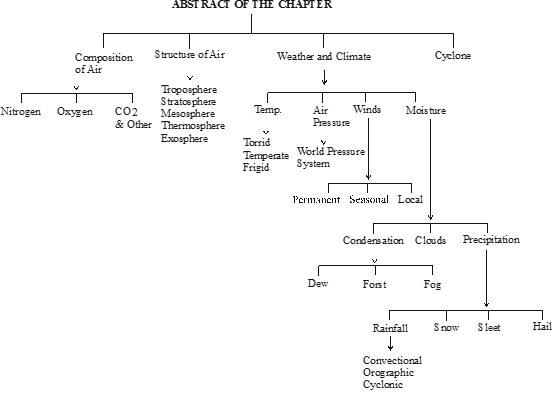
* INTRODUCTION
Air is a mixture of gases.
It surrounds our Earth.
We cannot perceive it when it is calm, but it is felt when the air is in motion.
The total mass of air surrounding our Earth is called atmosphere.
All living beings on this earth depend on the atmosphere for their survival.
It is held around the Earth because of the Earth’s gravitational force.
The atmosphere comprises of numerous gases, water particles, dust particles etc.
These gases, water particles and dust particles are necessary for the support of our life and that of plants and animals.
We inhale and exhale in this atmosphere.
Water vapour is also necessary for us. It is the source of rainfall without which we cannot live.
Uses of Air : It provides us the air we breathe and protects us from the harmful effects of the sun’s rays. Without this blanket of protection, we would be baked alive by the heat of the sun during day and get frozen during night. So it is this mass of air that has made the temperature on the earth liveable.
Composition : Nitrogen and oxygen are two gases which make up the bulk of the atmosphere. Carbon dioxide, helium, ozone, argon and hydrogen are found in lesser quantities. Apart from these gases, tiny dust particles are also present in the air.
1. (i) Nitrogen is the most plentiful gas in the air. 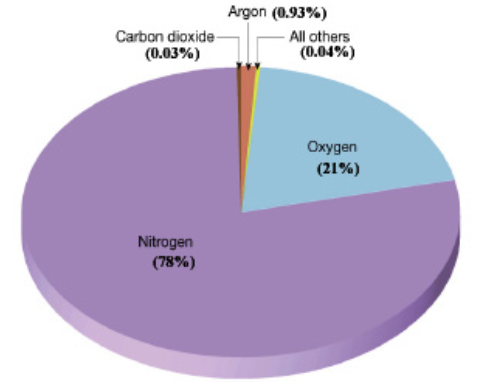
(ii) When we inhale, we take some amount of nitrogen into our lungs and exhale it.
(iii) Plants can not take nitrogen directly from the air.
(iv) Bacteria, that live in the soil and roots of some plants, take nitrogen from the air and change its form so that plants can use it.
2. (i) Oxygen is the second most plentiful gas in the air.
(ii) Humans and animals take oxygen from the air as the breathe.
(iii) Green plants produce oxygen during photosynthesis.
3. (i) Carbon dioxide is another important gas.
(ii) Green plants use carbon dioxide to make their food and release oxygen.
(iii) Humans or animals release carbon dioxide. The amount of carbon dioxide released by humans or animals seems to be equal to the amount used by the plants which make a perfect balance.
* Structure of the Atmosphere
Our atmosphere is divided into five layers starting from the earth’s surface. These are Troposphere, Stratosphere, Mesosphere, Thermosphere and Exosphere.
Troposphere 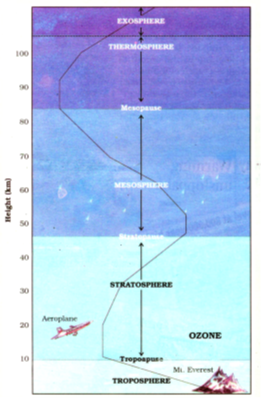
- This layer is the most important layer of the atmosphere.
- It average height is 13 km.
- The air we breathe exists here. Almost all the weather phenomena like rainfall, fog and hailstorm occur in this layer.
Stratosphere
- Above the troposphere lies the stratosphere.
- It extends up to a height of 50 km.
- This layer is almost free from clouds and associated weather phenomenon, making conditions most ideal for flying aeroplanes.
- One important feature of stratosphere is that it contains a layer of ozone gas. It protects us from the harmful effect of the sun rays.
Mesosphere
- This is the third layer of the atmosphere.
- It lies above the stratosphere. It extends up to the height of 80 km.
- Meteorites burn up in this layer on entering from the space.
Thermosphere
- In thermosphere temperature rises very rapidly with increasing height. Ionosphere is a part of this layer.
- It extends between 80 - 400 km. This layer helps in radio transmission. In fact, radio waves transmitted from the earth are reflected back to the earth by this layer.
Exosphere
- The upper most layer of the atmosphere is known as exosphere.
- This layer has very thin air. Light gases like helium and hydrogen float into the space from here.
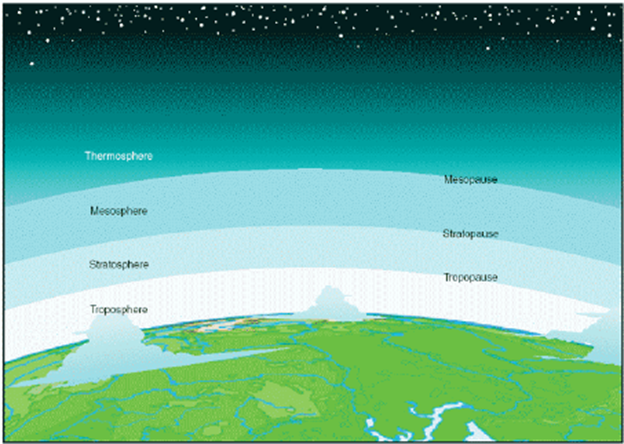
Illustration
What is the significance of dust particles and water vapour in the atmosphere?
Solution
These gases, water particles and dust particles are necessary for the support of our life and that of plants and animals. We inhale and exhale in this atmosphere. Water vapour is also necessary for us. It is the source of rainfall without which we cannot live.
* Weather and Climate
Weather is hour-to-hour, day to day condition of the atmosphere. Weather can change dramatically from day to day. However, the average weather condition of a place for a longer period of time represents the climate of a place.
Temperature
The degree of hotness and coldness of the air is known as temperature. An important factor that influences the distribution of temperature is insolation. Insolation is the incoming solar energy intercepted by the earth.
The amount of insolation decreases from the equator towards the poles. Therefore, the temperature decreases in the same manner. If the earth’s temperature rises too high, It would become too warm for some crops to grow. Temperature in cities is much higher than that of villages. The concrete and metals in buildings and the asphalt of roads get heated up during the day. This heat is released during the night. Also, the crowded high rise buildings of the cities trap the warm air and thus raise the temperature of the cities.
Air Pressure
Air above us presses us with a great force on our bodies. However, we don’t even feel it. This is because the air presses us from all directions and our body exerts a counter pressure.
Air pressure is defined as the pressure exerted by the weight of air on the earth’s surface. As we go up the layers of atmosphere, the pressure falls rapidly. The air pressure is highest at sea level and decreases with height. Horizontally the distribution of air pressure is influenced by temperature of air at a given place. In areas where temperature is high the air gets heated and rises. This creates a low-pressure area. Low pressure is associated with cloudy skies and wet weather.
In areas having lower temperature, the air is cold. It is therefore heavy. Heavy air sinks and creates a high pressure area. High pressure is associated with clear and sunny skies.
The air always moves from high pressure areas to low pressure areas.
Wind
The movement of air from high pressure area to low pressure areas is called wind. Winds can be broadly divided into three types.

1. Permanent winds: The trade winds, westerlies and easterlies are the permanent winds. These blow constantly throughout the year in a particular direction.
2. Seasonal winds: These winds change their direction in different seasons. For example monsoons in India.
3. Local winds: These blow only during a particular period of the day or year in a small area. For example, land and sea breeze.
Loo: The hot and dry local wind of northern planes of India is called loo.
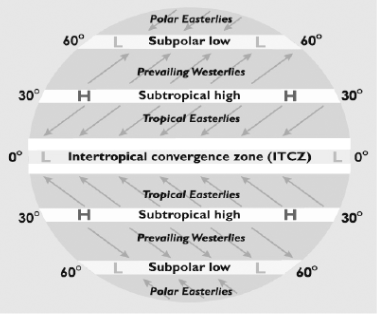
Moisture
When water evaporates from land and different water bodies, it becomes water vapour. Moisture in the air at any time, is known as humidity. When the air is full of water vapour we call it a humid day. As the air gets warmer, its capacity to hold the water vapour increases and so it becomes more and more humid.
Humidity
The actual amount of water vapour in a given volume of air is known as Total Humidity or Absolute Humidity. The absolute humidity is measured in grams per cubic metre.
The ratio between the actual amount of water vapour present in a given volume of air and the water vapour which the same volume of air can contain till its saturation level is called Relative Humidity. It is measured in terms of percentage.
* Condensation
Due to decrease in temperature the water vapour starts converting into liquid water droplets. This precess is called condensation. Condensation has various forms.
Dew
On cool nights during winter, when the Earth radiates heat and gets cooler, then the air which comes in contact with the cool ground also becomes cooler and water vapour starts condensing over the grass, tree leaves, etc., which could be seen in the early morning. This is called Dew.
Frost
During winter nights, when the temperature becomes very low, often reaching the freezing point, then the water vapour converts into tiny crystals of ice and could be seen as a white sheet on the sand particles, grass and other plants. This is called Frost.
Fog or mist
When the water vapour in the lower atmosphere condenses, but remain suspended in the atmosphere obstructing visibility, it is called FOG. Fog is normally thick with poor visibility. If it is thin with more visibility it is called Mist. Fog or mist normally develops during winter season due to low temperature.
* Precipitation
Precipitation is the process under which the condensed water vapours fall on the ground in various forms such as rain, snow, sleet and hail.
Precipitation that comes down to the earth in liquid form in called rain. On the basis of mechanism, there are three types of rainfall : the convectional rainfall, the orographic rainfall and the cyclonic rainfall.
Convectional Rainfall:
When a warm air motion ascend, its temperature decreases until reaching the dew point (quantity of water vapour that atmosphere can bear to a certain temperature) leading to clouds formation, and subsequent, to precipitation, usually in the form of showers.
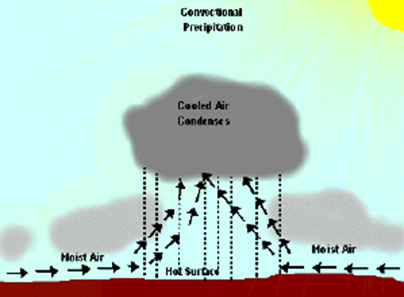
Orographic Rainfall:
When an air motion finds out an emphasis ascending area and consequently, reaches the dew point causing clouds. The precipitation occurs by normal processes already explained in previous posts.
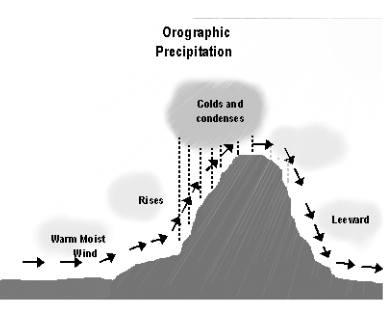
Cyclonic or Frontal Rainfall:
When an air motion finds a frontal surface, contact area between two air motions, it is forced to go up causing precipitation by the means described before.
In a warm front, the warm air moves above the cold air, rising up because it is less dense. This causes continuing rain, of great duration and low intensity.
In a cold front the cold air moves under the warmer, forcing it to rise. It causes intense rain, like showers.
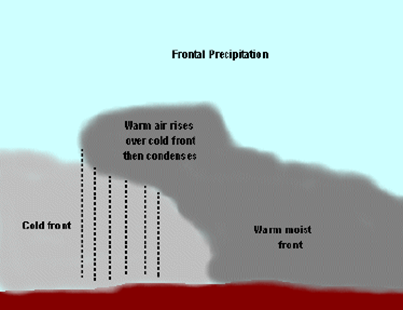
Rainfall is very important for the survival of plants and animals. It brings fresh water to the earth’s surface. If rainfall is less - water scarcity and drought occur. On the other hand if it is more, floods take place.
Snow:
When the condensation takes place at about freezing point or a little below the freezing point, then water vapour changes into tiny crystals of ice and fall on the ground in a soft cotton-like structure. This is called Snowfall.
![]()
Sleet:
Sleet is the combined occurrence of rain and snow.
Hail:
When the water droplets of rain happened to pass through a very cold air mass, they freeze into hard pelts of ice and fall on the ground. This is called Hail or Hailstone
Cyclone:
The cyclone originated as a “depression” in the Gulf of Thailand, near east of Port Blair, on 25 October 1999 and gradually moved in a northwestward direction. It intensified into a super cyclone and hit the area between Erasama and Balikuda in Orissa on 29 October at 10.30 a.m.
* Affective Area
The super cyclone swept entire the coast of Orissa including the cities of Bhubaneshwar and Cuttack and 28 coastal towns.
* Effects of Super Cyclone
(i) About 13 million people were affected.
(ii) A large number of livestock were killed.
(iii) Standing crops of paddy, vegetables and fruits were heavily damaged.
(iv) Due to salinisation caused by tidal surge, large tracts of agricultural land have turned infertile.
(v) Large tracts of sal, teak and bamboo plantations have disappeared.
(vi) The mangrove forests between Paradeep and Konark vanished.
* Facts to Know
1. Carbon dioxide released in the atmosphere creates a green house effect by trapping the heat radiated from the earth. It is therefore called a greenhouse gas and without it the earth would have been too cold to live in.
However, when its level in the atmosphere increases due to factory smoke or car fumes, the heat retained increases the temperature of the earth. This is called global warming. This rise in temperature causes the snow in coldest parts of the world to melt. As a result the sea level rises, causing floods in the coastal areas. There may be drastic changes in the climate of a place leading to extinction of some plants and animals in the long run.
2. When air is heated, it expands, becomes lighter and goes up. Cold air is denser and heavy. That is why it tends to sink down. When hot air rises, cold air from surrounding area rushes there to fill in the gap. That is how air circulation takes place.
3. You will be surprised to know that the earth receives only 1 in 2,000,000,0000 parts of the sun’s energy.
4. The standard unit of measuring temperature is degree Celsius. It was invented by Anders Celsius. On the Celsius scale the water freezes at 0°C and boils at 100°C.
5. On the moon there is no air and hence no air pressure. Astronauts have to wear special protective space suits filled with air when they go to the moon. If they did not wear these space suits, the counter pressure exerted by the body of the astronauts would make the blood vessels burst. The astronauts would bleed.
6. A wind is named after the direction from which it blows, e.g. the wind blowing from the west is called Westerly.
Illustration 1
What is the difference between fog and mist ?
Solution
When the water vapour in the lower atmosphere condenses, but remains suspended in the atmosphere obstructing visibility, it is called FOG. Fog is normally thick with poor visibility. If it is thin with more visibility it is called Mist.
Illustration 2
Bring out the relationship between temperature and pressure.
Solution
The temperature of the atmosphere varies from place to place. Whenever there is increase in the temperature of the air, it gets heated and expands in volume and becomes lighter. Due to less weight the heated air rises up causing low pressure. But at high altitude the same air gets cooled and becomes heavier and thus it descends down causing high pressure.

 Param Publication
Param Publication
